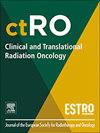A fully automated machine-learning-based workflow for radiation treatment planning in prostate cancer
IF 2.7
3区 医学
Q3 ONCOLOGY
引用次数: 0
Abstract
Introduction
The integration of artificial intelligence into radiotherapy planning for prostate cancer has demonstrated promise in enhancing efficiency and consistency. In this study, we assess the clinical feasibility of a fully automated machine learning (ML)-based “one-click” workflow that combines ML-based segmentation and treatment planning. The proposed workflow was designed to create a clinically acceptable radiotherapy plan within the inter-observer variation of conventional plans.
Methods
We evaluated the fully-automated workflow on five low-risk prostate cancer patients treated with external beam radiotherapy and compared the results with conventional optimized and inverse planned radiotherapy plans based on the contours of six different experienced radiation oncologists. Both qualitative and quantitative metrics were analyzed. Additionally, we evaluated the dose distribution of the ML-based and conventional radiation treatment plans on the different segmentations (manual vs. manual and manual vs. automation).
Results
The automatic deep-learning segmentation of the target volume revealed a close agreement between the deep-learning based and expert contours referring to Dice Similarity- and Hausdorff index. However, the deep-learning based CTVs had a significantly smaller volume than the expert CTVs (47.1 cm3 vs. 62.6 cm3). The fully automated ML-based plans provide clinically acceptable dose coverage within the range of inter-observer variability observed in the manual plans. Due to the smaller segmentation of the CTV the dose coverage of the CTV and PTV (expert contours) were significantly lower than that of the manual plans.
Conclusion
Our study indicates that the tested fully automated ML-based workflow is clinically feasible and leads to comparable results to conventional radiation treatment plans. This represents a promising step towards efficient and standardized prostate cancer treatment. Nevertheless, in the evaluated cohort, auto segmentation was associated with smaller target volumes compared to manual contours, highlighting the necessity of improving segmentation models and prospective testing of automation in radiation therapy.
用于前列腺癌放射治疗计划的全自动机器学习工作流程
人工智能与前列腺癌放疗计划的整合在提高效率和一致性方面表现出了希望。在本研究中,我们评估了基于全自动机器学习(ML)的“一键式”工作流的临床可行性,该工作流结合了基于ML的分割和治疗计划。提出的工作流程旨在在常规计划的观察者间变化范围内创建临床可接受的放疗计划。方法对5例低危前列腺癌患者行体外放射治疗的全自动工作流程进行评估,并根据6位不同经验的放射肿瘤学家的轮廓,将结果与传统的优化和逆计划放疗方案进行比较。对定性和定量指标进行了分析。此外,我们还评估了基于ml的放射治疗方案和常规放射治疗方案在不同时间段的剂量分布(手动vs手动,手动vs自动化)。结果基于深度学习的目标体自动分割结果表明,基于深度学习的轮廓与参考Dice Similarity- and Hausdorff index的专家轮廓非常吻合。然而,基于深度学习的ctv的体积明显小于专家ctv (47.1 cm3对62.6 cm3)。全自动基于ml的计划在人工计划中观察到的观察者间可变性范围内提供临床可接受的剂量覆盖。由于CTV的分割较小,CTV和PTV(专家轮廓)的剂量覆盖范围明显低于手动平面图。结论我们的研究表明,经测试的全自动ml工作流程在临床上是可行的,其结果与传统的放射治疗计划相当。这代表着朝着有效和标准化的前列腺癌治疗迈出了有希望的一步。然而,在评估的队列中,与人工轮廓相比,自动分割的靶体积更小,这突出了改进分割模型和自动化放射治疗的前瞻性测试的必要性。
本文章由计算机程序翻译,如有差异,请以英文原文为准。
求助全文
约1分钟内获得全文
求助全文
来源期刊

Clinical and Translational Radiation Oncology
Medicine-Radiology, Nuclear Medicine and Imaging
CiteScore
5.30
自引率
3.20%
发文量
114
审稿时长
40 days
 求助内容:
求助内容: 应助结果提醒方式:
应助结果提醒方式:


